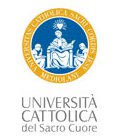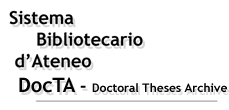|
|
DocTA - Doctoral Theses Archive >
Tesi di dottorato >
SCUOLA DI DOTTORATO IN ECONOMIA (DEFAP) >
Citazione:
Utilizza queste indicazioni per citare o creare un link a questo documento.
|
Pace, Maria Lucia. "INEQUALITY OF OPPORTUNITY IN ITALY", Università Cattolica del Sacro Cuore, XXIX ciclo, a.a. 2015/16, Milano, [http://hdl.handle.net/10280/35716].
|
| Titolo: | INEQUALITY OF OPPORTUNITY IN ITALY |
| Autore/i: | PACE, MARIA LUCIA |
| Tutor: | FEMMINIS, GIANLUCA |
| Coordinatore: | FEMMINIS, GIANLUCA |
| Lingua: | ENG |
| Abstract in italiano della tesi: | La diseguaglianza dei redditi è comunemente analizzata e misurata attraverso l’impiego di varie misure quali l’indice di Gini, il coefficiente di variazione, l’indice di Theil, la varianza dei logaritmi ed altri ancora (Sen, 1970). A partire dagli anni ’90 l’applicazione di tecniche di scomposizione relative, ad esempio, all’indice di Theil hanno reso possibile quantificare due diverse componenti della diseguaglianza ovvero la disuguaglianza legata allo sforzo individuale e la disuguaglianza dovuta alle ineguali opportunità. Questa seconda componente dipende esclusivamente da fattori esogeni, non controllabili dall’individuo, e, per questa ragione, è a ragione considerata una diseguaglianza “ingiusta”. Alla componente residua della scomposizione è di solito attribuito, invece, il significato di disuguaglianza nello sforzo, ovvero quanto ciascun individuo si è impegnato per raggiungere un determinato obiettivo di successo economico. L’applicazione di questo approccio alle misure di diseguaglianza ha permesso di studiare quale tipo di disuguaglianza prevalga all’interno di un Paese e, soprattutto, quali siano le circostanze esogene che incrementano la disparità nelle opportunità. Il presente lavoro si muove lungo questa linea di ricerca proponendo un metodo per testare il peso relativo delle due componenti e la loro significativita’. Come misura di diseguaglianza si e’ scelto di considerare il coefficiente di variazione in modo da ricondurre il test ad un problema di Analisi della varianza (ANOVA) a piu’ vie. Il test viene presentato facendo riferimento ai dati dell’ISTAT e dell'indagine Bankitalia sui redditi delle famiglie. Dopo quest'analisi preliminare sulle determinanti della diseguaglianza di opportunità in Italia, si utilizza la scomposizione della diseguaglianza nelle sue due componenti: diseguaglianza di opportunità e diseguaglianza legata all'impegno, per definire univocamente l'effetto della diseguaglianza sulla crescita economica. L'analisi econometria è svolta sui dati dell'indagine sulla ricchezza e sui redditi delle famiglie forniti dalla Banca d'Italia. L'effetto viene stimato utilizzando il modello panel dinamico con il metodo di stima GMM. |
| Abstract in inglese: | While the analysis of inequality has been central to economic studies for cen- turies, in recent years many studies concentrated on the distinction between in- equality of opportunity (IO) and inequality of returns to effort (IE) and attempted empirical estimates of the two components, e.g. in US and in Europe. The decompo- sition of a general inequality index into these two components allows to analyze the prevalence of fair or unfair income inequality within a country. This paper suggests to test the differences between the two sources of inequality in a simple way using the ANOVA framework adapted to decompose the coefficient of variation, to better suit the requirements of an inequality index. The proposed procedure is applied to the Italian Survey on Income and Living Condition (IT-SILC data, wave 2005 and 2011). The analysis of the results help identifying the circumstances that foster the rise of inequality of opportunities in Italy. Our analysis shows in particular, that father education, region of residence and gender result as the most relevant circumstances determining inequality of opportunity. On the other side, the role of mother education starting from a lower level, as an inequality of opportunity factor, is increasing its influence over time. The decomposition of inequality index in two components allows not only to analyze the prevalence of fair or unfair income inequality in a country, but also to find a clearer relation between inequality and growth. In fact, it is still missing an analysis of the relation between inequality of opportunity and economic growth in Italy. This paper aims at filling in that gap, by using Italian data from Bank of Italys Survey on Income and Wealth from 1998 to 2014. We choose the coefficient of variation to measure inequality of opportunity at the regional level and, then, we studied its relation with economic growth using Dynamic Panel Data models estimated through System- GMM. Finally, in order to check if the coefficient of variation could be a measure as good as the Entropy’s index, I will compare the results of the estimated panel models with the two different inequality of opportunity indeces. We evaluate the effect of inequality of opportunity on different length of the economic growth rate, going from a short term (2 years) to a very long term growth rate (10 years). Our results shows that, in Italy, inequality of opportunity is negative in the short period, but it does not have any effect on long run growth. |
| Data di discussione: | 13-ott-2017 |
| URI: | http://hdl.handle.net/10280/35716 |
| È visualizzato nelle collezioni: | SCUOLA DI DOTTORATO IN ECONOMIA (DEFAP)
FACOLTA' DI ECONOMIA
|
File in questo documento:
| File |
Dimensioni | Formato | Accessibilità |
|---|
| Thesis.pdf | 1,89 MB | Adobe PDF | non consultabile
|
|
Accesso e utilizzo dei contenuti di DocTA
|



